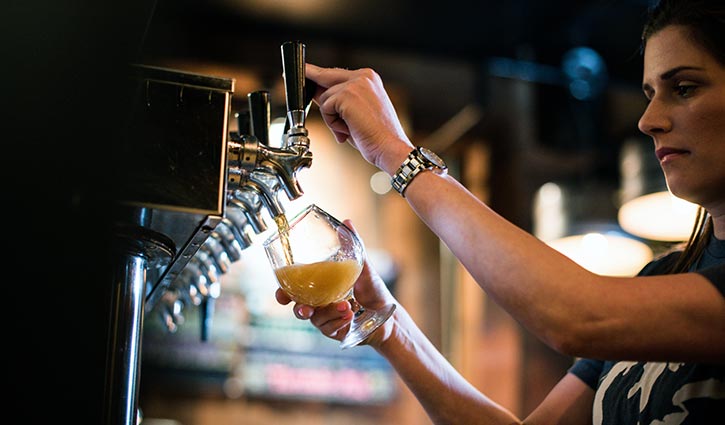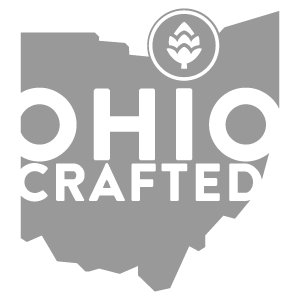
The Underground River of Beer
An underground river of beer? In Cleveland? The idea might raise some eyebrows and elicit a few guffaws, but this is no Willy Wonka fantasy. Beneath the hustle and bustle of West 26th Street, a stream of brewery-fresh beer flows to where it rightfully belongs: a pint glass. Thanks to two subterranean pipes connecting our brewery to our brewpub, craft beer fans are able to enjoy beer pumped directly from our brite tanks, the large vessels where finished beer rests before it’s packaged. It’s a setup that few (if any) other breweries in the U.S. have, and it’s why our beer tastes even fresher at the brewpub.
But how did this glorious tributary come to be? GLBC co-founder Dan Conway, Brewmaster Mark Hunger, and Plant Manager Mike Heidinger explain how we created our very own underground river of beer.
A river runs through it
To understand how the pipes got there in the first place, we need to look back at the brewing history of our campus. Our very first brewing system, Brewhouse No. 1, was installed (and still operates) in our brewpub on Market Avenue in 1988. Word of our little brewery quickly spread, and by 1992 we made our first expansion into the neighboring Fries & Schuele building, located just around the corner from the brewpub on West 26th Street. In the midst of a craft beer boom in the late-1990’s, we undertook our biggest expansion to date and began transitioning our production facility across the street into what is now our main production brewery, the former storage and stable facilities of the Leonard Schlather Brewing Company.
Between renovations and installation, getting the larger Schlather facility fully operational would take time, but beer still needed to be brewed. Without completely halting operation, how could the brewers maximize their brewing in the Fries & Schuele building while still using the extra space afforded to them in the new space? The answer: a series of underground pipes connecting the two buildings.
“At the time, it was a matter of production and space. One of the first things we did when we expanded into the Schlather building was adding fermenters, so the idea was we’d brew in the Fries & Schuele building and pump the beer across the street so that it could ferment,” says Hunger.
“The city was supportive of our expansion,” says Conway. “There were a number of construction and renovation projects happening to get the building up and running, so when we asked if we could dig up the road to lay down pipes, the city didn’t really mind.”
One street closure and a few days later, the underground beer pipes were laid down and connected, and freshly brewed wort was being pumped into the new brewery to ferment. But this setup was only temporary. By 2000, the entire operation had transitioned into the Schlather building where all of the brewing (and fermenting) was being done under one roof. So what became of the pipes? The brewers didn’t want to see a good thing to go waste.
“We essentially just reversed the flow,” says Hunger. With fresh beer sitting in brite tanks waiting to be enjoyed, the idea of Burning River flowing (literally) beneath West 26th street was an idea that was as awesome as it was practical.
But why?
For one thing, it’s efficient. Most of our higher volume releases (think year-round and seasonal beers) are all typically pumped over direct from the brewery. “The general rule of thumb is, if it’s a beer you can buy in a bottle, we’re probably pumping it over,” says Heidinger. It takes only about 15-20 minutes to pump over enough of one style for the brewpub, whereas kegging that same amount could take as long as 2 hours. “Last year we pumped in around 148,800 pints worth of fresh beer directly to the brewpub,” says Heidinger. “If we were to keg all of that, we’d be looking at around 1,200 kegs that would need to be filled in the brewery and then hauled over to the brewpub annually. Aside from how labor intensive that is, we don’t even have a cooler big enough to store that amount of extra kegs.”
But why not just brew the beer in the original system still operating in the brewpub? “If we were to even come close to brewing as much beer as we’d need for the brewpub, we’d be brewing in Brewhouse No. 1 night and day just to keep up with demand,” says Hunger. “If we did that, we wouldn’t have the flexibility to use that system to brew our small-batch pub exclusives.”
But perhaps most importantly of all…
It just tastes better this way. Fresh is best when it comes to beer, and the less packaging that’s done to a beer means it will remain at its highest quality longer. “The less beer is exposed to oxygen, the better,” explains Hunger. “We don’t even use a pumping system to get the beer over. The natural pressure from the tanks alone is enough, so the entire process is relatively easy on the beer.” And with crisp, bright, and refreshing flavors, our river of beer is easy on the taste buds, too.
Join us as we celebrate 30 years of award-winning craft brewing and taste the freshness for yourself by visiting our brewpub. Care to learn more? Sign up for a tour for a closer look at our brewery, our history, and our beer.
Words by Adam Ritterspach









